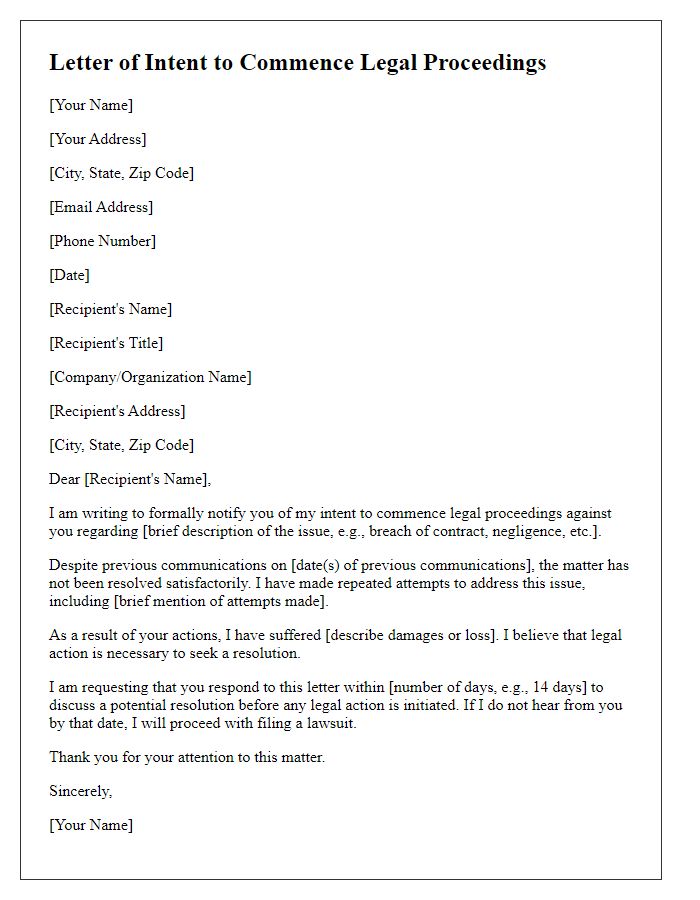Are you gearing up to initiate legal proceedings and unsure where to start? Writing a formal letter can be a daunting task, but it doesn't have to be. In this article, we'll break down the essential elements you need to include in your letter template to ensure clarity and professionalism. So, grab a pen and paper, and let's dive deeper into crafting the perfect letter that sets the tone for your legal journey ahead!

Clarity and precision in language
Initiating legal proceedings requires meticulous attention to detail, particularly in forming the intent to file documents. The notice of commencement must clearly delineate the parties involved, including their full legal names (e.g., John Smith, LLC or Jane Doe vs. XYZ Corporation), the jurisdiction (e.g., Superior Court of California, County of Los Angeles), and the cause of action (e.g., breach of contract or personal injury). Specific dates, such as the filing date (e.g., October 1, 2023) and the occurrence date concerning the dispute (e.g., July 15, 2023), must be highlighted. Clarity in articulating the claims, including relevant statutes or case law (e.g., California Civil Code Section 1542), enhances the precision of the document, aiding the court in understanding the legal framework surrounding the case. Such careful structuring fosters a comprehensive understanding of the legal issues at stake, ensuring proper procedural compliance and efficiency in the judicial process.
Identification of parties involved
In legal proceedings, the identification of parties involved is crucial for establishing jurisdiction and context. The plaintiff, the individual or entity initiating the lawsuit, often seeks remedy in a court of law, whereas the defendant, the person or entity being accused or sued, must respond to the claims. Specific details about each party, such as full legal names, addresses, and relationships to the case, are fundamental for clarity. For instance, in a suit involving business transactions, identifying the plaintiff as "XYZ Corporation, a Delaware corporation located in Wilmington, Delaware," highlights their registration status and locality, while designating the defendant as "John Doe, an individual residing at 123 Elm Street, Springfield," provides essential location and identity information important for formal notifications and potential legal service. Clearly defined parties enhance the legal document's precision and ensure all involved understand their roles in the proceedings.
Legal grounds for proceedings
Legal proceedings typically initiate based on well-defined legal grounds, with various laws and statutes guiding the process. For instance, contract disputes often stem from the breach of a legally binding agreement, which can involve amounts exceeding thousands of dollars, depending on the nature of the contract. Tort claims may arise from incidents occurring in specific jurisdictions, such as negligence cases leading to personal injuries, where plaintiffs seek compensation for damages that may reach millions. In family law, divorce proceedings can be initiated with grounds like irreconcilable differences or fault-based allegations, impacting asset distribution and custody arrangements. Each legal ground necessitates concrete evidence and adherence to procedural rules as outlined in local or federal court regulations, ensuring a structured approach to conflict resolution.
Required actions or responses
Commencing legal proceedings requires careful organization of required actions or responses. Initiating parties must gather essential documents, including the complaint (a formal statement outlining the grievance), summons (a notice to the defendant of the legal action), and any supporting evidence (photographs, contracts, or witness statements). The next step involves filing these documents with the appropriate court, such as a district court, and paying the necessary filing fees, which can vary widely based on jurisdiction, sometimes exceeding $400. Once filed, the plaintiff must ensure that the defendant receives proper service of process, delivered through personal service, certified mail, or a process server. Following this, the defendant must respond within a legally specified timeframe, often 20 to 30 days, by submitting an answer or a motion to dismiss. This sequence sets the stage for further legal proceedings, ensuring adherence to procedural rules in accordance with the governing legal framework, such as state or federal law.
Deadline for compliance or reply
In legal proceedings, a notification regarding compliance or reply deadlines serves as a crucial document. This document typically specifies a period of 14 days for the recipient to respond or comply with the outlined actions, ensuring adherence to court timelines. Such notices are often generated in formal settings like district courts, civil litigation cases, or family law disputes, emphasizing legal rights and obligations. Failure to meet the compliance deadline may result in sanctions, default judgments, or additional legal consequences under relevant statutes like Federal Rules of Civil Procedure. It is essential for parties involved to thoroughly understand these timelines to safeguard their interests effectively.













Comments